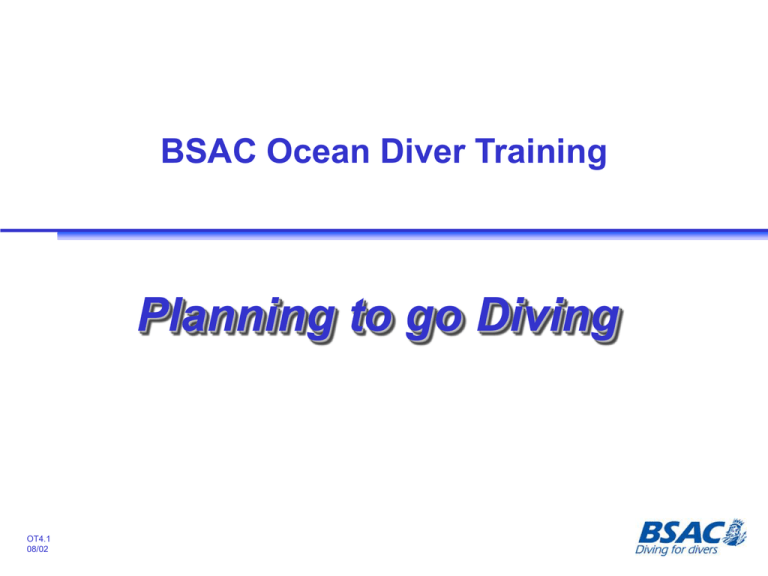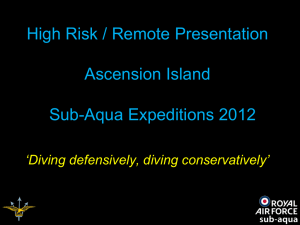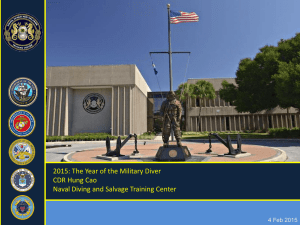PPT
advertisement

BSAC Ocean Diver Training Planning to go Diving OT4.1 08/02 Planning to go Diving Planning to go Diving Aims Every dive requires a plan for safety and enjoyment Two of the most important considerations Nitrogen management Ensuring sufficient breathing gas for the dive OT4 2 08/02 Planning to go Diving Diving & Effects of Nitrogen Atmosphere O2 79% Nitrogen, 21% Oxygen Nitrox A breathing gas usually having more than 21%O2 Gases Dissolve in the blood - a liquid Oxygen utilised, carbon dioxide produced Oxygen, carbon dioxide come out of blood as gases in alveoli Diving - ambient pressure increases OT4 3 08/02 Higher concentration of gas delivered to diver Higher concentration of gases dissolved in the blood including nitrogen N2 Planning to go Diving Nitrogen Absorption On the surface Nitrogen in body in equilibrium with air On a dive Increase in ambient pressure results in more nitrogen absorbed into body tissues - “on-gassing” Going deeper or longer increases body’s uptake of nitrogen Different tissues absorb nitrogen at different rates ‘Fast tissues - good blood supply ‘Slow’ tissues - poorer blood supply, fatty tissues OT4 4 08/02 Planning to go Diving Nitrogen Release On ascent Nitrogen released from tissues - “off-gassing” Tissues release nitrogen at different rates Body can tolerate a certain excess of nitrogen Nitrogen still being released when back on the surface If a diver ascends too quickly Nitrogen will be released as bubbles in the tissues or bloodstream Can cause Decompression Illness (DCI) Nitrogen release needs to be managed OT4 5 08/02 Planning to go Diving Nitrogen Management BSAC Decompression Tables Dive Computers Understanding the principles of tables will help to understand computers OT4 6 08/02 Planning to go Diving BSAC Tables - Definitions 1 Depth Deepest depth reached during the dive 6m Descent rate Maximum is 30m/minute Ascent rate Deepest Depth Maximum is 15m/minute up to 6m 1 minute from 6m to the surface 6m Ascent/Dive time check depth 6m pause to check dive time Dive time OT4 7 08/02 From leaving surface, to arriving at 6m Dive time Planning to go Diving BSAC Tables - Definitions 2 Current Tissue Code (CTC) Represents body’s present level of nitrogen saturation Starting point for dive planning CTC Surfacing Code (SC) Represents change to CTC at end of dive Tissue Codes : Nitrogen Load OT4 8 08/02 A B C D E F G SC Planning to go Diving Using BSAC Tables Ocean Divers Maximum depth 20 metres “No-Stop” dives for minimum risk - the white zone Ocean Divers dive within this area Table ‘A’ For divers with a CTC of ‘A’ OT4 9 08/02 Planning to go Diving BSAC Tables - Planning a No-Stop Dive Dive to 9m for 17 min. Surface Code is B If depth or time between values Use next longer time Use next greater depth Dive to 20m for 30 min. Surface Code is E OT4 10 08/02 Planning to go Diving Planning a Second Dive On the surface after a dive “Off-gassing” reduces tissue Nitrogen loading Surface Interval reduces Surfacing Code Gives new Current Tissue Code for the second dive Plan second dive shallower than first CTC SC CTC Surface Interval OT4 11 08/02 Planning to go Diving BSAC Tables - Using the Surface Interval Table To find your CTC for a second dive Enter at your SC Move across to Surface Interval Read new CTC from table Example SC = ‘E’ Surface interval + 5 hours New CTC = ‘B’ OT4 12 08/02 Planning to go Diving Table Levels Table ‘Level’ depends on atmospheric pressure Pressure range marked on each Table Use Altitude/Atmospheric Chart with Transfer Table When to use: OT4 13 08/02 Travelling - hills and mountains Living or diving at altitude Inland sites and bad weather Flying Planning to go Diving Flying & Diving Flying before diving Tissues off-gas Stresses of flying Recover before diving - 10 hours minimum Flying after Diving OT4 14 08/02 Increased level of off-gassing DCI Stresses of flying Ensure long Surface Interval between last dive and flying Need CTC of ‘A’ or ‘B’ Planning to go Diving Diving using BSAC Tables To Dive the Plan using Tables you need A depth gauge to monitor depth A dive watch to monitor time A dive slate as a reminder of the plan PLAN THE DIVE AND DIVE THE PLAN OT4 15 08/02 Planning to go Diving Dive Computers The basic functions: Theoretical body tissue ‘models’ to calculate nitrogen on and off-gassing A timer & pressure sensor Planning information depth/time Audible or screen warnings Stored log of previous dives Integrated temperature sensors OT4 16 08/02 Planning to go Diving Difference between Tables and Computers Dive Profile Profile of depth and time Dive Table Profile ‘Square’ profile ‘Calculated for maximum depth Dive Computer Profile Continuous tracking depth and time Continuous tracking of nitrogen load No-stop times vary from square profile of tables OT4 17 08/02 Planning to go Diving Plan the Dive and Dive the Plan Whether using Tables or Computers Two dives - plan the deepest first Never push the limits of tables or computers Table and computer mix, dive the tables Plan a dive that avoids “saw-tooth” profiles BSAC ’88 Tables allow for 3 dives in 24 hours Computers may have similar allowance Ensure a good surface interval after diving and before flying OT4 18 08/02 Planning to go Diving Using Tables or Computers Tables or Computers are not infallible They are planning tools to minimize the risk of DCI DCI can happen . . . Be fit to dive Avoid getting cold Do not dive in a dehydrated state Avoid excessive exercise Do not dive with a hangover Abort a dive if anxious or worried OT4 19 08/02 Remember Planning to go Diving Use of Nitrox to manage Nitrogen Ocean Divers may use 32% and 36% Nitrox mixes using air tables or air computers Advantages of Nitrox – less nitrogen means Safety factor Reduced risk of DCI Disadvantages of Nitrox Nitrox divers can still get DCI Certain equipment must be dedicated to the use of Nitrox Oxygen Toxicity (explained in OT6) OT4 20 08/02 Planning to go Diving Introducing BSAC NITROX Tables Ocean Divers “No-Stop” dives using 32% Nitrox, planned on 21% air table Maximum depth 20 metres Ocean Divers dive within this area Table ‘A’ For divers with a CTC of ‘A’ OT4 21 08/02 Planning to go Diving Nitrox – Procedures and Practices Higher percentage of oxygen Oxygen supports combustion Materials and greases must be safe with higher oxygen percentages Equipment must be cleaned periodically removing combustible contaminants Percentages must be checked with an O2 analyser before use Follow analyser manufacturer’s guidance Must not use gas more than 1% different from desired mix All cylinders should be marked with mix % and MOD OT4 22 08/02 Planning to go Diving Nitrox – Using an analyser 1. Switch on the gas analyser 3. Slowly open the valve - gas gently hissing out OT4 23 08/02 2. Calibration - essential before use 4. Present the analyser to the cylinder valve Planning to go Diving Nitrox – Analysing a mix 5. Take a reading 6. Record the analysis OT4 24 08/02 Planning to go Diving Analysing essentials Calibrate prior to use Keep flow rate even and low as possible Erratic readings point towards a analyser failure Avoid windy conditions Avoid moisture Your analysis must be within +/- 1% of your target mix Store analyser away from elevated oxygen levels OT4 25 08/02 Planning to go Diving Dive Planning – Breathing Gas The rule for planning and monitoring breathing gas on a dive Rule of Thirds 1/ One third gas supply for descent, to half way or turn around point One third gas supply for second half of dive or return journey including ascent One third gas supply as a reserve OT4 26 08/02 1/ 3 1/ 3 3 Planning to go Diving Breathing Gas Planning The Rule of Thirds 10 Litre cylinder filled to 210 bar Divide 210 bar by 3 = 70 bar for each 1/3 of dive First third 210 - 70 = 140 bar - at turn around/half way point Second third 140 - 70 = 70 bar - at surface Third third 70 leaves approximately 70 bar as reserve Always aim to surface with 1/3 cylinder as reserve OT4 27 08/02 Planning to go Diving Gas Monitoring Always monitor contents gauge throughout a dive – it’s your lifeline! Running low or out of gas should not arise under normal diving conditions Gas consumption increases when: Physical effort increases Divers are cold or anxious Shorten or terminate the dive OT4 28 08/02 Planning to go Diving Summary Plan the Dive and Dive the Plan Management of Nitrogen Tables or computer Plan with common sense Management of Breathing Gas Rule of Thirds and constant monitoring OT4 29 08/02 Planning to go Diving OT4 30 08/02









